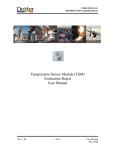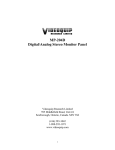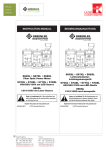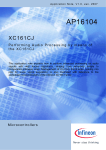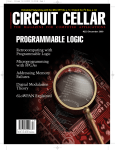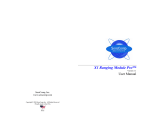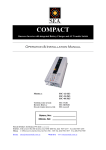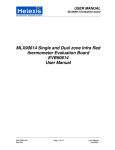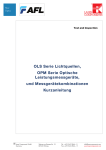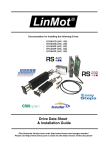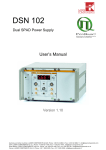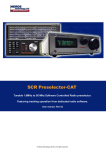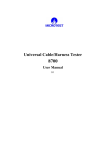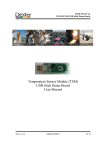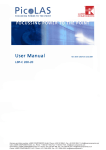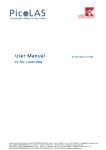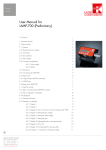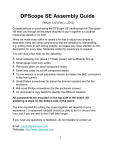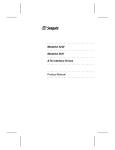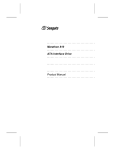Download (TSM) Evaluation Board User Manual
Transcript
USER MANUAL MD-0004 TSM Evaluation Board Temperature Sensor Module (TSM) Evaluation Board User Manual Germany and other countries: LASER COMPONENTS GmbH, Phone: +49 8142 2864 0, Fax: +49 8142 2864 11, [email protected] Great Britain: LASER COMPONENTS (UK) Ltd., Phone: +44 1245 491 499, Fax: +44 1245 491 801, [email protected] France: LASER COMPONENTS S.A.S., Phone: +33 1 3959 5225, Fax: +33 1 3959 5350, [email protected] USER MANUAL MD-0004 TSM Evaluation Board Table of Contents 1 2 3 4 5 6 7 Rev. 1.00 Dec./2009 Introduction…………………………………………………………… Host computer requirements………………………………………….. Installing the software ………………………………………………... Where to begin with the MD-0004 EVB……………………………… 4.1 Evaluation board overview……………………………………. Where to begin with the MD-0004 PC software……………………… 5.1 Temperature Sensor Module overview………………………... 5.2 Running Temperature Sensor Module software………………. 5.3 Main window buttons…………………………………………. 5.4 Measuring Temperature Monitor button……………………… 5.5 Advanced Features button……………………………………. 5.5.1 Memory button…………………………………………. 5.5.2 Config button…………………………………………… 5.6 Console button……………………………………………….. 3 4 4 5 6 7 7 7 8 9 10 10 11 12 Hardware Block Diagram ……………………………………………. 13,14 Disclaimer ……………………………………………………………. 15 2 of 15 Germany and other countries: LASER COMPONENTS GmbH, Phone: +49 8142 2864 0, Fax: +49 8142 2864 11, [email protected] Great Britain: LASER COMPONENTS (UK) Ltd., Phone: +44 1245 491 499, Fax: +44 1245 491 801, [email protected] France: LASER COMPONENTS S.A.S., Phone: +33 1 3959 5225, Fax: +33 1 3959 5350, [email protected] USER MANUAL MD-0004 TSM Evaluation Board 1. Introduction The Dexter Temperature Sensor Module (TSM), (p/n: MD-0003) consists of the industry standard Dexter ST-60 with a special embedded signal conditioning ASIC inside the TO-5 can. Due to the low noise amplifier, 17-bit high resolution ADC and powerful DSP of the TSM very accurate non-contact temperature measurements can be achieved. Factory Calibrated object and ambient temperatures is available in RAM of TSM accessible by the industry standard serial SMBus protocol or via 10-bit PWM (Pulse Width Modulated) output of the device. The SMBus allows for multiple zone temperature control – up to 100 sensors can be read via four common wires. Traditional IR Detector voltage output is in the microvolt range requiring specialized electronics to minimize noise, readout electronics, calibration and compensation for system integration. Using the integrated ASIC with our detectors inside the TO-5 can: • • • • • • • • Electronics is placed at the detector, greatly reducing electrical noise. Temperature measurements now in digital format. System integration time and expertise is reduced Less OEM time to market Lower system costs Smaller footprint Plug and Play Calibrated output from factory System Flexibility The evaluation kit, (p/n: MD-0004) is designed to support the infrared temperature sensor modules (TSM). The communication between PC and the evaluation board is accomplished via USB. The Evaluation Kit contains the following items: 1. FS USB evaluation board (EVB), pre-programmed with USB a boot loader and demonstration firmware. 2. A standard USB cable for use in communicating with the board. 3. 1 pcs. MD-0003 TSM (single zone 5V) 4. CD-ROM, containing the PC USB HID driver and evaluation software. 5. Quick start guide. The main purpose of the evaluation kit is to allow customers to configure the TSM for virtually any application quickly. Customers can quickly evaluate the TSM for temperature ranges, optics, etc. to find the best configuration to meet their application needs without the need to design any additional hardware. Once the best configuration is established, customers can easily configure the TSM for their own use. The Evaluation Board is based on the Microchip PIC18F4550 which offers a cost completive hardware designs, low cost development tools and software which could be an excellent starting point for any hardware design. Dexter offers design services and could customize the evaluation board to meets your needs as well. Rev. 1.00 3 of 15 User Manual Dec./2009 Germany and other countries: LASER COMPONENTS GmbH, Phone: +49 8142 2864 0, Fax: +49 8142 2864 11, [email protected] Great Britain: LASER COMPONENTS (UK) Ltd., Phone: +44 1245 491 499, Fax: +44 1245 491 801, [email protected] France: LASER COMPONENTS S.A.S., Phone: +33 1 3959 5225, Fax: +33 1 3959 5350, [email protected] USER MANUAL MD-0004 TSM Evaluation Board 2. Host computer requirements For the evaluation to function correctly the following hardware and software requirements must be met: • PC-compatible system • An available USB port • CD-ROM drive (for use with the accompanying CD) • Microsoft Windows XP or higher. 3. Installing the software The evaluation board requires very little effort to install. Most of the work is done by the installation software. Without the EVB connected to the PC, insert the install CD drive. If auto run is enabled on your system the software installation should start automatically. If not simply click on the file “drc_tsm_2_05_setup.exe” on the CD drive to start the process. After the USB drivers are installed you will be asked to connect the evaluation board to a USB port on the computer. To connect the evaluation board: 1. Unpack and unwrap the board, and set it on a non-conductive surface near the host system. You man elect to place the four rubber feet at each corner of board at this time. 2. Connect the USB cable (supplied in the kit) to an open USB port on the host system, and to the USB connector on the board. The LED will shine in BLUE. 3. Check the board connection after software installation. This can be done from Start/Settings/Control Panel/System/Hardware/Device Manager (Fig. 3.1). Jungo/tsm_usb and WinDriver Fig. 3.1 The software will be installed in a separate Dexter Research directory and can be accessed from a shortcut on desktop “DRC_TSM_02” or Start/Programs/Dexter Research Center/DRC_TSM_02. Rev. 1.00 4 of 15 User Manual Dec./2009 Germany and other countries: LASER COMPONENTS GmbH, Phone: +49 8142 2864 0, Fax: +49 8142 2864 11, [email protected] Great Britain: LASER COMPONENTS (UK) Ltd., Phone: +44 1245 491 499, Fax: +44 1245 491 801, [email protected] France: LASER COMPONENTS S.A.S., Phone: +33 1 3959 5225, Fax: +33 1 3959 5350, [email protected] USER MANUAL MD-0004 TSM Evaluation Board 4. Where to begin with the MD-0004 EVB 4.1 Evaluation board overview. 9. 1. 10. 2. 5. 6. 7. 12. 3. 4. 8. 11. 13. FIG 4.1 Top View 14. FIG 4.2 Bottom View Rev. 1.00 5 of 15 User Manual Dec./2009 Germany and other countries: LASER COMPONENTS GmbH, Phone: +49 8142 2864 0, Fax: +49 8142 2864 11, [email protected] Great Britain: LASER COMPONENTS (UK) Ltd., Phone: +44 1245 491 499, Fax: +44 1245 491 801, [email protected] France: LASER COMPONENTS S.A.S., Phone: +33 1 3959 5225, Fax: +33 1 3959 5350, [email protected] USER MANUAL MD-0004 TSM Evaluation Board Fig.4.1. shows the top view of the evaluation board. The highlighted areas are: 1. Test socket for TSM, from supplier: Linear Sales Wells/CTI (p/n 611-1040314) TSM (p/n: MD-0003) Dexter placed in test socket. Please note how the device is installed in socket. White alignment tab on EVB silkscreen and tab on TSM. 2. VDD test point. Positive voltage applied to TSM module. 3. Microchip PIC18F4550. 4. USB Connector 5. Test points SCL, SDA and GND. Ideal point to monitor SMBus signals with an Oscilloscope. 6. RESET button, EVB board and Microchip PIC18F4550 reset. 7. Status LED. Blue - Board has power, has not communicated with PC software. Green - TSM has power applied, communicating with PC software. RED - TSM does not have power applied, it’s OK to change TSM devices when LED is RED! NOTE: At NO time should the TSM be inserted or removed if the LED is GREEN (see Fig. 4.1 item 7). VDD is applied to the test socket with the GREEN status; damage to the module may occur. 8. NEXT and START buttons, available for application program use. START buttons is used for upgrading Microchip PIC18F4550 firmware. 9. J1. Extension connector footprint gives provisions to have additional TSM modules connected to SMBus. This connector is a Molex (p/n 70553-0003) and is readily available from many suppliers such as Digikey (p/n: WM4902-ND) Connector SMBus pins: pin1 - SCL/Vz (arrow ) pin2 - PWM/SDA pin3 - Vdd pin4 – Vss / GND 10. Dexter has designed the EVB with some additional general features that could be used by our customers if needed. One feature of the TSM is the ability for SDA pin to be use as a thermostat output. Additional hardware could be soldered to the board which would give a relay output to J5. Please contact Dexter for further information. 11. The MD-0004 evaluation board receives its power supply only from the USB cable, Bus-Powered Device. An external power supply source is not needed. However should you have a need to use the EVB without the USB cable; it is possible to have an external power source via J4 with additional hardware soldered to the board. Please contact Dexter for further information. 12. J2. ICD port connector to the Microchip PIC18F4550. Should you elect to develop your own application software the In Circuit Debugger port of the microprocessor is available. 13. IC1 8K x 8 serial EEPROM, possible uses data logging, TSM configuration storage. Additional hardware could be soldered to the board, requires additional software. Rev. 1.00 6 of 15 User Manual Dec./2009 Germany and other countries: LASER COMPONENTS GmbH, Phone: +49 8142 2864 0, Fax: +49 8142 2864 11, [email protected] Great Britain: LASER COMPONENTS (UK) Ltd., Phone: +44 1245 491 499, Fax: +44 1245 491 801, [email protected] France: LASER COMPONENTS S.A.S., Phone: +33 1 3959 5225, Fax: +33 1 3959 5350, [email protected] USER MANUAL MD-0004 TSM Evaluation Board 14. Fig. 4.2 bottom view. If desired you could mount the test socket to the other side of the EVB. The EVB has been designed to mount in a standard Serpac enclosure (WM021), available from Digikey SRW021-WA-ND. You have two mounting option, to the top or bottom covers depending how long you need the test socket to extend out the enclosure. Placing the test socket on the bottom side of the EVB and mounting the EVB to the top cover will yield the longest extension of the test socket. 5. Where to begin with the MD-0004 PC software. 5.1 Temperature Sensor Module overview. The Temperature Sensor Module software is a Windows-based application designed to be used with the MD-0004 EVB for evaluating Dexter MD-0003 series infrared non-contact Temperature sensor modules. The TSM features and performance can be evaluated using the software in conjunction with the EVB hardware. All basic configurations of MD-0003 are also supported in a user-friendly application. Device configurations are written in EEPROM of each MD-0003 and then will be the Power on Reset defaults. This provides a way to configure the MD-0003 for use in target applications. 5.2 Running Temperature Sensor Module software. Insert a MD-0003 device into the ZIF test socket. Verify that the alignment tab on the MD-0003 matches the silkscreen on the EVB, (see Fig. 4.1 item 1). At NO time should the TSM be inserted or removed if the LED is GREEN (see Fig. 4.1 item 7). VDD is applied to the test socket with the GREEN status; damage to the module may occur. Launch the software from shortcut on desktop “DRC_TSM_02” or Start/Programs/Dexter Research Center/DRC_TSM_02. Startup screen will be appearing on desktop: Rev. 1.00 7 of 15 User Manual Dec./2009 Germany and other countries: LASER COMPONENTS GmbH, Phone: +49 8142 2864 0, Fax: +49 8142 2864 11, [email protected] Great Britain: LASER COMPONENTS (UK) Ltd., Phone: +44 1245 491 499, Fax: +44 1245 491 801, [email protected] France: LASER COMPONENTS S.A.S., Phone: +33 1 3959 5225, Fax: +33 1 3959 5350, [email protected] USER MANUAL MD-0004 TSM Evaluation Board After loading, the software will automatically recognize the TSM type, voltage, SMBus address and open the main screen. The status LED will be GREEN indicating power is applied and communication is established. Note: should the LED not turn Green it may be due to a number of items, i.e. TSM installed incorrectly or not at all. Should this be the case Please press the reset button on the EVB and re-start the software. FIG 5.1 5.3 Main window buttons. Power button and Power Status. Button turn off power to MD-0003, status LED will turn RED. Reload button and Power Status. Re-start system and turns on power to the MD-0003, status will turn GREEN. Reset button. Reset the MD-003. Exit button. Exit the program. Rev. 1.00 8 of 15 User Manual Dec./2009 Germany and other countries: LASER COMPONENTS GmbH, Phone: +49 8142 2864 0, Fax: +49 8142 2864 11, [email protected] Great Britain: LASER COMPONENTS (UK) Ltd., Phone: +44 1245 491 499, Fax: +44 1245 491 801, [email protected] France: LASER COMPONENTS S.A.S., Phone: +33 1 3959 5225, Fax: +33 1 3959 5350, [email protected] USER MANUAL MD-0004 TSM Evaluation Board Console button. Pulls up the Console screen to allow you to monitor USB commands sent to the EVB. Also allow you to send individual command to the EVB. Monitor button. Pulls up the Monitor temperature screen to graph both object and ambient temperatures. Advanced button. Pulls up the Advanced features screen menu. Changing configurations, reading and writing both EEPROM and RAM can be preformed. Help button. Pulls up this User Manual. 5.4 Measuring Temperature Monitor button. From the Main window click on the Monitor button. This will open the Monitor window screen and allow you to simply display, plot and capture temperature data. See Fig. 5.2 If PWM mode is selected, the label will changed to: “PWM Object Temperature” That Monitor window screen will allow you to display, plot and capture PWM temperature data. Fig. 5.2 Here you can select Celsius or Fahrenheit scale. Set minimums and maximums for both Object and Ambient Temperatures. This set the resolution of the graphs and thermometer on the screen only; it has no effect on the MD-0003 settings. The slider bar in the middle of the screen “Update Time (ms)” sets the time scale that readings are taken from the MD-0003. (100 ms to 500 ms.) Click the “Start” button to begin taking measurements and update graphs. Clicking the “Save Log” button will allow you to log a date and time stamped readings for both temperatures to an Excel csv file. Note. You must specify a file of your choice each time you click the “Save Log”. Data is always appended to this file never erased. Button will be RED when data log feature is enabled. Rev. 1.00 9 of 15 User Manual Dec./2009 Germany and other countries: LASER COMPONENTS GmbH, Phone: +49 8142 2864 0, Fax: +49 8142 2864 11, [email protected] Great Britain: LASER COMPONENTS (UK) Ltd., Phone: +44 1245 491 499, Fax: +44 1245 491 801, [email protected] France: LASER COMPONENTS S.A.S., Phone: +33 1 3959 5225, Fax: +33 1 3959 5350, [email protected] USER MANUAL MD-0004 TSM Evaluation Board 5.5 Advanced Features button. From the Main window click on the “Advanced” button. This will give you three more buttons to choose from: “Config”, “Uploader” and “Memory”. Config button will allow you to change several configurations of the MD-0003 and save them in EEPROM . This will be the new Power On Reset setting of the MD-0003. Uploader button will be available in a near future software release. Allows you to upload new firmware to the EVB. Memory button. Allows you to view the contents of the EEPROM and RAM on the MD-0003 in a memory array matrix. Fig. 5.3 5.5.1 Memory button. Clicking on the “Memory” button displays the contents of both the MD-0003 RAM and EEPROM in a hexadecimal format. “Refresh” button will reread the MD-0003, useful with the RAM display to show raw sensor data. RAM addresses of interest * Ambient sensor data – RAM addr = * IR data RAM addr = * Linearized ambient temperature Ta RAM addr = * Linearized object temperature To RAM addr = 0x03h 0x04h 0x06h 0x07h See Data sheet for information on other address. Fig. 5.4 Rev. 1.00 10 of 15 User Manual Dec./2009 Germany and other countries: LASER COMPONENTS GmbH, Phone: +49 8142 2864 0, Fax: +49 8142 2864 11, [email protected] Great Britain: LASER COMPONENTS (UK) Ltd., Phone: +44 1245 491 499, Fax: +44 1245 491 801, [email protected] France: LASER COMPONENTS S.A.S., Phone: +33 1 3959 5225, Fax: +33 1 3959 5350, [email protected] USER MANUAL MD-0004 TSM Evaluation Board 5.5.2 Config button. Clicking on the “Config” button allows you to change how the MD-0003 is configured to operate. These settings are stored in the MD-0003 EEPROM and will be the Power on Defaults. Fig 5.5 From this window the user can configure the MD-0003. A short description of every setting field follows below. For a detailed description of the settings please refer to the MD-0003 datasheet. * * * * * * * * * * * SMBus address - set SMBus slave address. All values between 0 and 7F are valid. All MD-0003 will accept communication with slave address 0. Therefore in SMBus network a slave address 0 will be useless. PWM mode - defines single or extended PWM mode PWM struct - selects what data will be transmitted via the PWM. PWM period repetitions - defines how many times each PWM period will be repeated. Any even number of repetitions from 0 to 62 is valid PWM period - defines the PWM period. Available settings in drop-down menu. PWM pin configuration - chooses between NMOS “open drain” and “push pull” PWM output. F.I.R filter- Available settings for digital filter in drop-down menu. Slower settings comes with less noise. I.I.R filter [%] – drop-down list of available values for impulse limit. 100% passes all impulse, 50% cuts impulse magnitude in half via the embedded ASIC IIR filter. Note: that the settling time depends on both FIR and IIR filters settings. K-Emissivity – adjust the emissivity of the target object. To max, To min - defines the temperature ranges for object temperature. Ta man, Ta min - defines temperature ranges for ambient temperature. Before changing any value you should click the “READ” button to insure values are current. You can save the configuration to file of your choice by clicking the “Save Config” button. Now you can restore the TSM to the original values later by clicking “Load Config” button and choosing the file saved. Click “WRITE” button to send any changes to the MD-0003. Rev. 1.00 11 of 15 User Manual Dec./2009 Germany and other countries: LASER COMPONENTS GmbH, Phone: +49 8142 2864 0, Fax: +49 8142 2864 11, [email protected] Great Britain: LASER COMPONENTS (UK) Ltd., Phone: +44 1245 491 499, Fax: +44 1245 491 801, [email protected] France: LASER COMPONENTS S.A.S., Phone: +33 1 3959 5225, Fax: +33 1 3959 5350, [email protected] USER MANUAL MD-0004 TSM Evaluation Board 5.6 Console button. From the Main window click on the Console button. This will open the Console window screen to allow you to monitor the commands sent over the USB port to the EVB. It also allows you to send individual commands to the MD-0003. A drop down menu is given for the available command to send. Fig 5.5 “Clear Log” button will clear data from the log section. “Send Command” button will transmit the selected command to the MD-0003. Here is a list of the available commands from the drop down menu. * Reset Module - Same as Power off and Refresh in one button. * Switch to SMBus – Issues a request for the MD-0003 to go into SMBus mode. * Capture PWM – If the MD-0003 is configured for PWM will take a reading. * Read Ram – enables the address field to select address 0 -31 of the MD-0003 RAM. Data will be place in the console. Rev. 1.00 12 of 15 User Manual Dec./2009 Germany and other countries: LASER COMPONENTS GmbH, Phone: +49 8142 2864 0, Fax: +49 8142 2864 11, [email protected] Great Britain: LASER COMPONENTS (UK) Ltd., Phone: +44 1245 491 499, Fax: +44 1245 491 801, [email protected] France: LASER COMPONENTS S.A.S., Phone: +33 1 3959 5225, Fax: +33 1 3959 5350, [email protected] USER MANUAL MD-0004 TSM Evaluation Board * Read EEPROM - enables the address field to select address 0-31 of the MD-0003 EEPROM. Data will be place in the console. * Write EEPROM - enable the address field to select address 0-31 of the MD-0003 also enables Value 1 and Value 2 fields for data entry to write at the assigned address. You are allowed to write data only to specific addresses: 0x00 thru 0x06 and 0x0E. Otherwise, the message “Writes to this address is not allowed. Please see user manual for more information ” will appear on the console. * Power Off - Turns off power to the MD-0003, status LED will turn RED. 6. HARDWARE BLOCK DIAGRAM J4 7-24 VDC POWER SUPPLY Vdd PROG. VREG 3 or 5 Vdd USB J3 4.8V PS J1 SMBus EXTENSION U4 SMBus Driver JP2 SMBus TEST SOCKET PIC 18F4550 SDA RESET SW SW START SW NEXT SW J5 RELAY OUTPUT IC1 8K X 8 EEPROM J2 ICD Rev. 1.00 13 of 15 User Manual Dec./2009 Germany and other countries: LASER COMPONENTS GmbH, Phone: +49 8142 2864 0, Fax: +49 8142 2864 11, [email protected] Great Britain: LASER COMPONENTS (UK) Ltd., Phone: +44 1245 491 499, Fax: +44 1245 491 801, [email protected] France: LASER COMPONENTS S.A.S., Phone: +33 1 3959 5225, Fax: +33 1 3959 5350, [email protected] USER MANUAL MD-0004 TSM Evaluation Board NEXT and START buttons, available for application program use. START buttons is used for upgrading Microchip PIC18F4550 firmware. Dexter has designed the EVB with some additional general features (shown in RED) that could be used by our customers if needed. Additional hardware could be soldered to the board for these features. Please contact Dexter for further information. J1. SMBus extension connector footprint gives provisions to have additional MD-0003 TSM modules to be connected to SMBus. This connector is a Molex 70553-0003 and is readily available from Digikey WM4902-ND Connector SMBus pins: pin1 - SCL/Vz (arrow ) , pin2 - PWM/SDA, pin3 – Vdd , pin4 – Vss / GND J5 Relay output: One feature of the TSM is the ability for SDA pin to be use as a thermostat output. To use this feature you would most likely want the external power supply as well for standalone operation. Connector pins: pin 1 – Normally Closed, pin2 – Common, pin 3 – Normally Open. Also the Microprocessor can have the ability to drive the relay with addition software development. J4 The MD-0004 evaluation board receives its power supply only from the USB cable, Bus-Powered Device. External power supply source is not needed. However should you have a need to use the EVB without the USB cable; it is possible to have an external power source via J4. Connector pins: pin 1 & 2 – ground, pin 3 – 7 to 24 VDC. J2 ICD port connector to the Microchip PIC18F4550. Should you elect to develop your own application software the In-Circuit-Debugger port of the microprocessor is available. Connector pins: pin 1 – Reset, pin 2 – 4.8 VDC, pin 3 – GND, pin 4 – PGD, pin 5 – PGC, pin 6 – NC. IC1 8K x 8 serial EEPROM, possible uses standalone data logging, TSM configuration storage. Requires additional software. U4 LTC1694-1IS5#TRMPBF SMBus Driver: Should you be using long cables with J1 SMBus extension it may be required to use this driver with the additional capacitive load. Rev. 1.00 14 of 15 User Manual Dec./2009 Germany and other countries: LASER COMPONENTS GmbH, Phone: +49 8142 2864 0, Fax: +49 8142 2864 11, [email protected] Great Britain: LASER COMPONENTS (UK) Ltd., Phone: +44 1245 491 499, Fax: +44 1245 491 801, [email protected] France: LASER COMPONENTS S.A.S., Phone: +33 1 3959 5225, Fax: +33 1 3959 5350, [email protected] USER MANUAL MD-0004 TSM Evaluation Board 7. Disclaimer Devices sold by Dexter are covered by the warranty and patent indemnification provisions appearing in its Term of Sale. Dexter makes no warranty, express, statutory, implied, or by description regarding the information set forth herein or regarding the freedom of the described devices from patent infringement. Dexter reserves the right to change specifications and prices at any time and without notice. Therefore, prior to designing this product into a system, it is necessary to check with Dexter for current information. This product is intended for use in normal commercial applications. Applications requiring extended temperature range, unusual environmental requirements, or high reliability applications, such as military, medical life-support or life-sustaining equipment are specifically not recommended without additional processing by Dexter for each application. The information furnished by Dexter is believed to be correct and accurate. However, Dexter shall not be liable to recipient or any third party for any damages, including but not limited to personal injury, property damage, loss of profits, loss of use, interrupt of business or indirect, special incidental or consequential damages, of any kind, in connection with or arising out of the furnishing, performance or use of the technical data herein. No obligation or liability to recipient or any third party shall arise or flow out of Dexter’ rendering of technical or other services. © 2009 Dexter Research Center, Inc. All rights reserved. www.lasercomponents.com 0/ / V1 / ,) / GUF/ WVPBXVHUPDQXDO.pdf Germany and other countries: LASER COMPONENTS GmbH, Phone: +49 8142 2864 0, Fax: +49 8142 2864 11, [email protected] Great Britain: LASER COMPONENTS (UK) Ltd., Phone: +44 1245 491 499, Fax: +44 1245 491 801, [email protected] France: LASER COMPONENTS S.A.S., Phone: +33 1 3959 5225, Fax: +33 1 3959 5350, [email protected]















